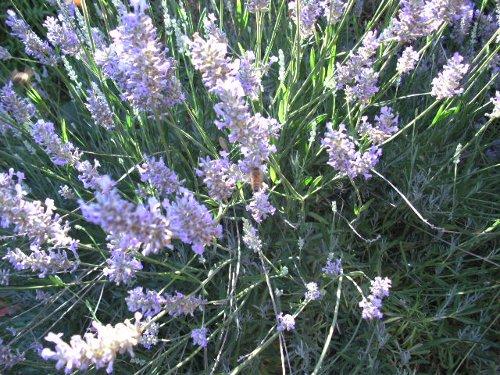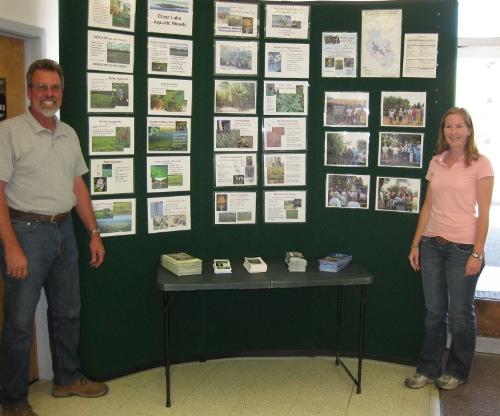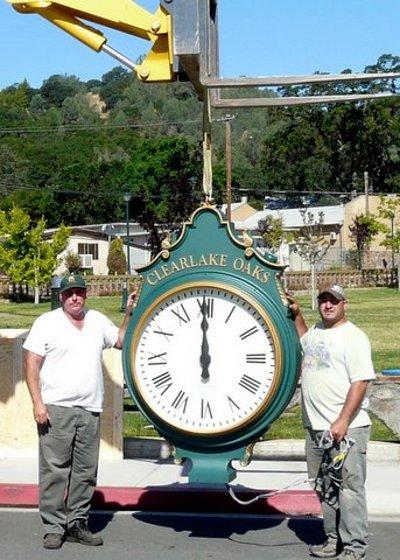
A bee enjoys lavender at the home of Lisa Cole in Clearlake, Calif., on the morning of Saturday, July 10, 2010. Photo by Esther Oertel.
I’m sitting outdoors in Petaluma as I write this, the sun on my back and lush fields of blooming lavender in view. I didn’t plan this happy coincidence. It just so happens that my in-laws, whom I’m visiting, live next door to the Lavender Bee Farm, a fixture on the Sonoma County Farm Trails map.
A stone’s throw away, hundreds of stalks with their deep purple blooms wave gently in the breeze. They’re planted row upon row, filling nearly every inch of the neighbor’s several acre plot, reminiscent of photos of lavender fields in France.
It’s interesting that the stalks, though loosely splayed, retain the integrity of the rotund shape of the shrub, almost like neat rows of aromatic sea urchins. The deep green foliage at each shrub’s base makes for a striking contrast of color.
What’s planted next door is English lavender, from which the lavender used in potpourris and cuisine comes. There are well over 25 species of lavender, including Spanish, Dutch, Mexican and French, but it’s English lavender that has become famous in the French countryside.
The name lavender is derived from the Latin word lavare, which means to wash. Lavender has long been used as a fragrance in soaps and shampoos, extending back to ancient Rome, where lavender was used to scent Roman baths.
So valuable was lavender in ancient Rome, a pound of the harvested flowers sold for the equivalent of a month’s wages. The Romans thought lavender was important enough to take with them when they conquered southern Britain, thus becoming the ancestor of the many varieties of English lavender we know today.
Though lavender is most widely known in the sunny Mediterranean region, it is speculated that this member of the mint family originated in Asia. It’s grown in gardens throughout the world, and since lavender cross-pollinates easily, there are countless variations within each species.
There is recorded evidence going back 2,500 years showing lavender’s use as a stewing herb, a mood tonic, a fragrance, an insect repellent and a food flavoring.
The distinctively pungent aroma of lavender is used in aromatherapy as a calming influence; in fact, scientific studies confirm that the scent of lavender produces calming, soothing and sedative effects. The ancient Greeks crushed and burned it to create a relaxing fume.
Lavender-filled pillows are a common folk remedy for insomnia – my neighbor told me just this morning that she sleeps with a small bag of lavender under her pillow – and modern research suggests that this may be an effective remedy. It has been found that the scent of lavender slows the activity of the nervous system and improves sleep quality.
A few evenings ago, I had the privilege of cutting lavender from the abundant bushes of a generous friend. It was a calm, quiet dusk, and a lone bumblebee was my companion as I inhaled deeply of the fragrant blossoms while trimming the stalks. I went away calmer than I had arrived, and I credit the lavender for the quieting of my spirit.
I’ve spent some time in recent weeks researching the many culinary uses of lavender and have been surprised to find just how extensively lavender can be used in a wide swath of culinary genres, both sweet and savory.
It can be made into vinegars, salad dressings, flavored oils, and rubs for fish and meat. It flavors whipped cream and chocolate, is baked into scones and is added to lemonade. It’s added to stews, sauces and ice cream, makes a fragrant aioli, and is delicious when paired with goat cheese. It’s steeped for tea, flavors coffee and adds an aromatic element to spiced teas, such as lavender chai.
The real question is whether there’s a way lavender CAN’T be used in cuisine.

Veggie Girl Esther Oertel harvested a little lavender from the garden of Lisa Cole in Clearlake, Calif., on Saturday, July 10, 2010. Photo by Esther Oertel.
If you’re lucky enough to have a lavender bush on your property or, like me, have generous friends who allow you to harvest their crop, there are endless ways to make use of it.
Lavender should be harvested in the early blossom stage, before they are fully open. Do this early in the day, after the dew has dried. Moisture impedes the drying process, so harvest your lavender on a dry day.
I find that bees are less abundant in the early morning and in the dim light of evening, which makes harvesting a bit easier.
Use rubber bands to tie the lavender stalks into small bunches, and hang them upside down in a dry (and, ideally, dark) place. It doesn’t take long for the buds to dry, perhaps one or two weeks.
Depending on the location, place a clean sheet under the lavender to trap falling blossoms, or loosely tie a paper bag under each hanging bundle.
When dry, shake the lavender into a paper bag, or wrap each bundle in a clean pillow case and roll it as you would a rolling pin. Gather the dried buds from the bag or pillow case and pick or sieve out the larger bits of plant. The remaining dry stems can be used to toss into a fireplace for aroma or into a barbecue for flavor.
The recipe I offer here is a rather exotic one, perfect for a light summertime meal. If needed, culinary lavender can be purchased at gourmet shops. Enjoy!
Seared ahi tuna with lavender-pepper crust
Mustard seed dressing (recipe follows)
1 1/2 pounds center-cut ahi tuna or four (4- to 6-ounce) 1-inch thick sushi quality tuna steaks
1 teaspoon coarse salt
2 teaspoons black peppercorns
1 teaspoon white peppercorns
2 teaspoons fennel seeds
1 1/2 teaspoons dried culinary lavender flowers
3 tablespoons extra-virgin olive oil
4 cups savory mixed fresh greens and herbs
Prepare mustard seed dressing; set aside.
If using the center-cut ahi tuna, trim and cut the tuna into a block approximately 2 inches across; then cut into 1-inch steaks.
Crush the salt, peppercorns, fennel seeds, and lavender with a mortar and pestle or a rolling pin. Lightly oil the tuna with 2 teaspoons of the olive oil; evenly coat the tuna with the lavender-pepper mixture, patting off any excess.
In a heavy bottomed sauté pan or a cast-iron pan, heat the remaining 1 tablespoon olive oil. Increase the heat to high and place the tuna in the pan. Sear for 1 minutes, then turn over carefully, reducing the heat to medium. Sear the other side for 1 more minutes until medium rare. Remove from heat and immediately refrigerate the tuna for at least 1 hour but no more than 3 hours.
To serve, arrange the greens on chilled individual serving plates. Drizzle with mustard seed dressing. Thinly slice the tuna and arrange on top of the dressed greens.
Makes 8 servings.
Mustard seed dressing
4 tablespoons prepared whole-grain mustard
2 tablespoons extra-virgin olive oil
2 teaspoons toasted mustard seed
2 tablespoons seasoned rice vinegar
3 tablespoons vegetable stock or water
1 teaspoon honey (or to taste)
Coarse kosher salt and freshly ground black pepper
Preheat oven to 375 degrees F. Place mustard seeds in a baking pan. Place in oven and roast for a couple of minutes (watch carefully so the seeds don't burn). Remove from oven and let cool. Whisk all the ingredients together and season to taste.
Esther Oertel, the "Veggie Girl," is a personal chef and culinary coach and is passionate about local produce. Oertel owns The SageCoach Personal Chef Service and teaches culinary classes at Chic Le Chef in Hidden Valley Lake. She welcomes your questions and comments; e-mail her at This email address is being protected from spambots. You need JavaScript enabled to view it..
Follow Lake County News on Twitter at http://twitter.com/LakeCoNews and on Facebook at http://www.facebook.com/pages/Lake-County-News/143156775604?ref=mf .


 How to resolve AdBlock issue?
How to resolve AdBlock issue? 













